Honda: Pilot News
#401
Team Owner
because :USA:
The following users liked this post:
ttribe (02-20-2015)
#404
Team Owner
grass is always greener on the other side.
Other countries that have Amber wanted to change it to red and people with red in the USA want to change it to Amber...
Other countries that have Amber wanted to change it to red and people with red in the USA want to change it to Amber...
#405
אני עומד עם ישראל
Call me crazy, but I'd rock it over the Highlander.
The following users liked this post:
TSX69 (04-10-2015)
#407
Ex-OEM King
welp, no real reason to get the MDX anymore. The new Pilot comes with an AWD system that's similar to SHAWD.
Also, there isn't the infuriating dual screen infotainment system.
Only Honda I'd buy right now if I wanted an Odyssey without sliding doors.
Also, there isn't the infuriating dual screen infotainment system.
Only Honda I'd buy right now if I wanted an Odyssey without sliding doors.
The following users liked this post:
F23A4 (05-23-2015)
#409
Team Owner
Honestly, I still think the first gen Pilot had the best looking exterior, to date. 

#410
Ex-OEM King
#411
Senior Moderator
More details.
Temple of VTEC Rumors and News - Honda releases more details on 2016 Pilot
I'd be perfectly happy in a EX or EX-L. Lets hope pricing is reasonable.
Temple of VTEC Rumors and News - Honda releases more details on 2016 Pilot
I'd be perfectly happy in a EX or EX-L. Lets hope pricing is reasonable.
The following users liked this post:
F23A4 (05-23-2015)
#413
You'll Never Walk Alone
iTrader: (1)
Join Date: Jun 2005
Location: Vancouver, BC, Canada
Age: 37
Posts: 9,492
Received 834 Likes
on
518 Posts
Honda is serious about competing head on against Grand Cherokee and Explorer with this new Pilot.
The current MDX is an excellent SUV, but this Pilot seems to be even more loaded than the MDX, at a lower price too.
I wonder when the MDX will get its MMC and what sort of of changes will we see.
The current MDX is an excellent SUV, but this Pilot seems to be even more loaded than the MDX, at a lower price too.
I wonder when the MDX will get its MMC and what sort of of changes will we see.
#418
Team Owner
Maybe the photos aren't doing it justice, but it just looks so god damn generic. The Grand Cherokee looks much more attractive.
#419
Three Wheelin'
More details.
Temple of VTEC Rumors and News - Honda releases more details on 2016 Pilot
I'd be perfectly happy in a EX or EX-L. Lets hope pricing is reasonable.
Temple of VTEC Rumors and News - Honda releases more details on 2016 Pilot
I'd be perfectly happy in a EX or EX-L. Lets hope pricing is reasonable.
#420
The Third Ball
Join Date: Sep 2002
Location: Los Angeles, Ca
Age: 45
Posts: 49,121
Received 4,824 Likes
on
2,571 Posts
Now...(and Im biased) the Durango looks more attractive and it drives like a dream.
If there was no Durango...Im betting the new Pilot is probably a great buy and great drive. Even though Im not sold on the looks.
#421
Team Owner
The 3rd row seats would never be used, at least in my case, so I would cross shop the two. But yes, I'll agree, Durango > Pilot.
#422
Senior Moderator
This Pilot owner sez.....I'd rock it. I like the look. My wife likes the look (she says it is similar to the Buick Enclave  she's otherwise eyeing, I disagree but....umOK). Is it finally time to retire our 8-year-old, 102k mile Pilot? In Touring guise, it's a better deal than the MDX and the wife doesn't care as much about SH-AWD as much as I do.
she's otherwise eyeing, I disagree but....umOK). Is it finally time to retire our 8-year-old, 102k mile Pilot? In Touring guise, it's a better deal than the MDX and the wife doesn't care as much about SH-AWD as much as I do.
 she's otherwise eyeing, I disagree but....umOK). Is it finally time to retire our 8-year-old, 102k mile Pilot? In Touring guise, it's a better deal than the MDX and the wife doesn't care as much about SH-AWD as much as I do.
she's otherwise eyeing, I disagree but....umOK). Is it finally time to retire our 8-year-old, 102k mile Pilot? In Touring guise, it's a better deal than the MDX and the wife doesn't care as much about SH-AWD as much as I do.
#423
Safety Car
Weíre bombing along a stretch of northern Kentucky back road, pushing ever harder into wide sweepers and tight switchbacks as lush rolling hills dotted with weathered black barns and Baptist churches whiz by. Itís the type of route more suited to a sports car (note to self: come back here with 1), but the 2016 Honda Pilot is handling its business and handling it extremely well for a 3-row crossover.
Yeah, yeah, we know. Virtually no 1 is going to go tear-assing across Kentucky bluegrass country in an all-new Honda Pilot like we are, but what the route so fittingly illustrates is how much more refined the 2016 Pilot is dynamically, how much better its powertrain performs under pressure. If itís this good out here, then we can only image how good the new Pilot will be trundling along on the suburban soccer-game-shuttling circuit.

Just as important though, if not more so, is what the all-new, completely redesigned 2016 Pilot brings to the segment in the way of safety, efficiency, amenities, and packaging. These are critical areas customers care deeply about when mulling a vehicle like the Pilot, and Hondaís U.S.-based design and engineering teams believe theyíve over-delivered. After a couple of days poking, prodding, and otherwise putting the whip to the new Pilot, weíre struggling to find any reason to disagree.
1 glance at the exterior will tell you this isnít the same old Pilot. A prominent swept-back, 3-bar chrome grille, boomerang-shaped LED daytime running lamps, and an aggressively styled fascia lend it a car-like appearance at the front. Along the flanks and at the rear, the Pilot is now more in line with the rest of the segment, with extensive wind-tunnel testing influencing the design approach. Honda officials told us 1 of the biggest reasons why prospective customers didnít buy the outgoing Pilot was because its boxy appearance projected a more utilitarian and, by extension, inefficient package.

Among the few familiar components from the previous model is the 3.5-liter V-6, still the only engine option available for the Pilot. While the same basic design, the new 6 spent a long session on Hondaís Earth Dreams efficiency massage table and came out newly refreshed, with features including direct injection and cylinder deactivation. While power is up (280 horsepower and 262 lb-ft of torque, a bump of 30 hp and 9 lb-ft), overall vehicle weight is down by as much as 300 pounds, depending on configuration.

Also helping move the mpg ratings needle up are 2 new automatic-transmission options depending on trim level: a new-to-Pilot 6-speed and a new-to-Honda 9-speed. We spent the majority of our seat time in Pilots equipped with the 9-speed, and itís unquestionably the box to rock. It never spent any time hunting around, it kicked down with authority when summoned, and it operated more fluidly under hard acceleration than the 6-speed. The 9-speedís flat-panel, center-console-mounted gearshift control is also less obtrusive than the 6-speedís more traditional stalk, and itís the most efficient transmission, with an estimated 20/27 mpg city/highway for 2-wheel-drive models and 19/26 mpg for all-wheel-drive models.

The 2016 Pilotís other major upgrade in the powertrain department is its all-new variable traction management system, dubbed i-VTM4. Honda is billing it as the most advanced torque vectoring all-wheel-drive system in the class. Thanks to the addition of an all-new electronically controlled and hydraulically actuated rear differential unit, i-VTM4 can distribute up to 100 percent of torque to either rear wheel depending on the situation, a key addition to the more traditional front-to-rear axle distribution and braking-based torque vectoring of other vehicles in its class. Also in the mix is a traction-control management system that optimizes the throttle mapping, transmission shift mapping, stability control, and i-VTM4 torque distribution on all-wheel-drive models. There are Normal, Mud, Sand, and Snow modes for all-wheel drive and Normal and Snow for front-wheel-drive models.

The primary difference we could discern between the all-wheel- and front-wheel-drive models was the front-drive Pilotís tendency to torque steer when we pegged the gas pedal. It was virtually nil in the all-wheel-drive models with i-VTM4, and out on the twisted Kentucky 2-lanes the system seemed to help us hug the line a smidge better during aggressive cornering. Dynamically, suspension and steering feel were superb regardless of model, thanks to its independent front (struts) and multilink rear setup, as well as improvements to damper and spring rates and bigger, 20-inch wheels on upper-level trims (18-inchers are the other rim/tire option). Its upgraded brakes, featuring 12.6-inch ventilated discs at the front, slowed the big crossover down with little drama. The 2016 Pilot felt composed and far from harsh over cracked-up pavement, and its motion-adaptive electrically assisted power steering helps initiate inputs and exhibits a progressive and linear steering feel that rivals many near-luxury sport sedans -- not too tight or too light, but just right.

Along with the suspension and handling upgrades, the Pilot benefits from a lighter and more rigid body construction thatís safer, more structurally sound, and uses more advanced materials than before, including ultra-high-strength steel. Confidence is extremely high that the Pilot will ace government crash-test regulations thanks to improvements such as a ď3-boneĒ structure under the front floor, which helps deflect energy away from occupants in the event of a front impact.
So itís built to keep you safer in the event of a crash, but like many new vehicles on the market the all-new 2016 Honda Pilot features a suite of tech designed to keep you from getting into a smashup in the 1st place. Called Honda Sensing, the safety and driver-assist group is designed to make driving the Pilot easier and safer. Along a stretch of the I-71 freeway just outside of Cincinnati, we were speeding up, slowing down, and going with the flow thanks to the Pilotís adaptive cruise control. With the lane-keeping assist feature, you can perform the ďlook, Ma, no handsĒ routine for about 15 seconds until the fun-police alert asks you to get your hands on the wheel. Meander out of the lines, and the lane-departure warning fires up.

Turning off a sweeping exit onto another roadway, the traffic in front of us slows considerably, and the adaptive cruise tries but canít hustle us down quickly enough. Suddenly itís 4-alarm-fire time. The forward-collision warning says pump the brakes before the collision-mitigation braking system does it for us. We happily oblige. Crisis averted. Itís an impressive suite of technologies that will be coming to more Hondas in the future.
Also hugely impressive is the new Honda Pilotís cabin, which is miles better in materials and execution than the outgoing model, and itís quieter at speed thanks to myriad improvements on the noise, vibration, and harshness front. Step in and sit down, and the leather seats are arguably the most comfortable in the segment. They do a decent job of lateral support as well. The center stack is dominated by a newly designed, 8-inch navigation and infotainment setup (save the LX trim, which gets by with a 5-inch LCD unit), complemented by a 4.2-inch color screen in the middle of the instrument panel. It uses an Android-based operating system, with Garmin helping with the satellite-based navigation. Other than a little fussiness we experienced with the capacitive touchscreen (you can swipe, tap, and pinch), itís a superior setup.

Name a contemporary comfort, convenience, or entertainment feature, the Pilot likely has it as either standard or available equipment. Among them: Bluetooth HandsFreeLink; real-time traffic info; Pandora; multiple stereo options; voice text messaging and voice navigation; new generation SiriusXM with playback features; and Apple Siri Eyes Free. Want to see the sky in all rows? Order the Elite and get the available panoramic glass roof. Are the kids not entertained? Get the 9-inch, ceiling-mounted rear entertainment system with available Blu-ray disc capability and multiple inputs including an available HDMI input.

The rest of the center stack is neatly arranged with a minimum of buttons, and all are designed to fall easily to hand, especially the ventilation. Youíll find 5 USB ports in all, 4 of which are set up for quick charging. In the center console the storage bin area has been redesigned to more easily store purses, iPads, kitchen sinks, etc.

Dimensionally, the new Pilot has a 1.8-inch-longer wheelbase than before, and much of that room has been used to maximize the space behind the rear seats and in the 3rd row. Open the door to the 2nd row, hop in, and youíll find either a bench or captainís chair setup (Elite trim) depending on a 7- or 8-passenger configuration and plenty of room to stretch out in either. At the outside base of the second-row seats youíll see a small button. Push it, and the seat will roll forward and tilt. Itís a quick trick to aid access to the 3rd row, which is easier to get into due to ingress/egress improvements. Bonus: The 3rd row isnít a penalty box for adults.
When you want to haul stuff, the cargo area is bigger, better, and more configurable than before. With the 3rd row up, you can fit a massive 82-quart cooler thanks to improvements in the overall packaging. Drop the 2nd- and 3rd-row seats and 109 cubic feet of space opens up; thatís better than any vehicle in its class save the Chevy Traverse (116 cubic feet). The Pilot can also tow if need be, with a maximum rating of 5,000 pounds.

The 2016 Honda Pilot is available in a host of trim levels, from the bare-bones, front-drive LX ($30,875) to the fully loaded, all-wheel-drive Elite ($47,300), which comes with virtually everything you can get for the vehicle. Regardless of trim level, the new Pilot is arguably the new class of the 3-row crossover class -- especially when youíre kicking some ass along a stretch of Bluegrass State back road.
PHP Code:
2016 Honda Pilot Specifications
Base Price: $30,875
Engine: 3.5L SOHC 24-valve V-6/280 hp @ 6,000 rpm, 262 lb-ft @ 4,700 rpm
Transmission: 6- or 9-speed automatic
Layout: 4-door, 7-8-passenger, front-engine, FWD/AWD SUV
EPA Mileage: 18-20/26-27 mpg city/hwy
Suspension F/R: Struts, coil springs, anti-roll bar/multilink, coil springs, anti-roll bar
Brakes F/R: Vented discs/discs
Tires F/R: 245/60-R18 105H (LX, EX, EX-L); 245/50-R20 102H (Touring, Elite)
L x W x H: 194.5 x 78.6 x 69.8 in
Wheelbase: 111.0 in
Headroom (1st/2nd/3rd row): 39.5-40.1/39.9-40.2/38.9 in
Legroom (1st/2nd/3rd row): 40.9/38.4/31.9 in
Shoulder Room (1st/2nd/3rd row): 40.9/38.4/31.9 in
Cargo Room (behind 3rd/2nd/1st row): 18.0-18.5/55.0-55.9/108.5-109.2 cu ft
Towing: 3,500-5,000 lb
Weight: 3,131 lb
Weight Dist. F/R: 56.1-58.1/41.9-43.9%
0-60 MPH: N/A
1/4-Mile: N/A
Top Speed: N/A
#424
Team Owner
I thought last Gen Camry's taillights were the ugliest of the decade, until today.....
I dont like the exterior at all, looks like it came from China.
I dont like the exterior at all, looks like it came from China.
The following users liked this post:
TacoBello (08-11-2015)
#425
Moderator
I have to admit, I like what I'm seeing out of the new Pilot. It's the first time I've started considering a Honda as a replacement for our existing (and aging) 2003 Pilot EX-L.
#426
Safety Car
For all it had going for it, the 2nd-generation Honda Pilot was stung by 1 undeniable fact: it looked like a big, boxy SUV at a time when consumer favor was shifting towards car-based crossovers. For 2016, though, Honda is offering a 3rd-generation Pilot that not only does away with the old model's brutalist looks, but also adopts bleeding-edge safety technology and fuel-efficient powertrains.
The Pilot's new styling still doesn't really work, to our eyes. That's not because of the CR-V-inspired headlights or Accord-derived grille. It's not even because of the horizontally oriented, reshaped taillights. The biggest problem with the Pilot is its profile. The hood is an inch lower for 2016, and the CUV is 3.5 inches longer than its predecessor with an extra inch ahead of the front axle. Simply put, the proportions are out of whack. The hood is too short, the passenger compartment too large, and the beltline too low. It's little wonder then that both Autoblog staffers and readers have pointed out the 2016 Pilot's minivan-like resemblance.
Changes underneath the Pilot's sheetmetal are just as drastic. Honda incorporated a mix of high-strength steel, aluminum, and even magnesium to create the CUV's new bones. Taken as a whole, our top-of-the-line Elite tester is 286 pounds lighter than the previous model, while being 25 percent more rigid overall.
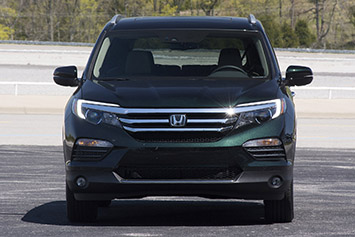
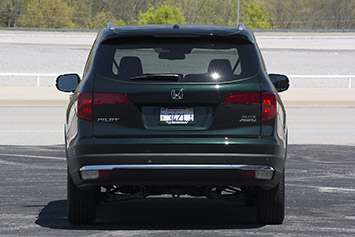
Aside from some penny pinching in the cabin Ė the hard plastic on the top of the rear door panels is particularly egregious Ė the Pilot's interior is home to soft-touch plastics, quality leather, and handsome piano black accents. Front passengers are treated to broad, comfortable, power seats, complete with heating and ventilation (depending on trim). What they lack in outright support through the turns, they make up for in long-haul comfort.
Honda will continue to sell the Pilot with seating for 8, but for the very 1st time, it's also offering a pair of captain's chairs in place of the 2nd-row bench. Either setup is comfortable, though the 7-passenger layout allows easier access to the 3rd row. As for the way-back, it can accommodate 2 kids or 2 adults in a pinch, but we aren't sure how Honda thinks 3 humans of any size will fit back there.
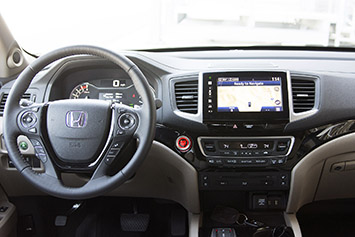
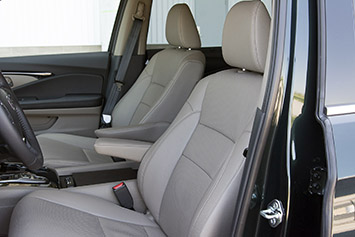
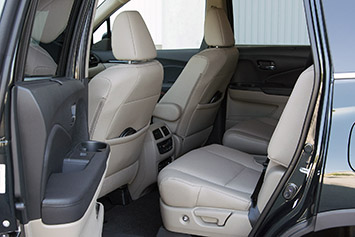
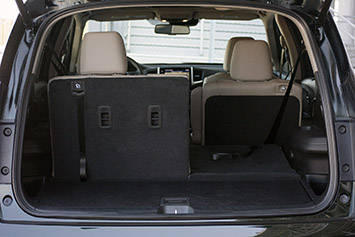
Happily, Honda ditched the 2-screen center stack setup found elsewhere in its model range. The Pilot's ample 8-inch display (standard on the Touring and Elite trims) has menus that are easy to manage. A version of the Android operating system and Garmin navigation make up a pleasing software suite. That said, the touch-capacitive controls that sit on the driver's side of the display aren't very responsive, and when combined with the lack of haptic feedback, left us wondering if the 'buttons' had even registered our inputs.
There's an additional 4.2-inch display in the instrument cluster that replaces the analog speedometer Ė that's right, the digital speedo is all you get. Flanked by the counter-rotating needles of the tachometer, fuel, and temperature gauges, the screen displays everything from trip info to the current setting of the Intelligent Traction Management system. But screen real estate is only the most obvious display of tech in the Pilot Ė there's more electronic voodoo hiding under the skin. The infotainment system has a pair of fascinating new features: the DVR-like Tune Start and the playlist-creating Tune Mix, for the SiriusXM satellite radio.

The Honda Sensing system provides a comprehensive suite of computer-controlled nannies designed to keep things copacetic while driving. Road Departure Mitigation is a Honda 1st and works with the lane departure warning system to keep distracted drivers from straying off the road. Rather than relying on audio and visual driver alerts, RDM will actively apply steering and braking power as needed. It works like a dream.
Like the old Pilot, the only engine on offer is a 3.5-liter V6. But it's a new powerplant, hailing from Honda's Earth Dreams family. The engine puts out 280 horsepower and 262 pound-feet of torque, up from the outgoing engine's 250 hp and 253 lb-ft. With a drive-by-wire throttle, direct injection, a stop-start system, active engine mounts, and the latest version of Honda's variable cylinder management system, this is a far more advanced engine than the Pilot's old V6. The end result is a crossover that feels potent. Power is ample throughout the rev range. On top of that, the new electric throttle is sharp, responsive, and easy to modulate.

Beyond performance, the engine exudes a sense of refinement. It's quiet when cruising, but when it does start to sing, its note is smooth and sonorous. Honda added active engine mounts in a bid to quell any NVH issues in everyday driving and from the start-stop system. It works, eliminating any unpleasantries.
For base models, a 6-speed automatic transmission takes the place of the Pilot's old 5-speed unit. But a ZF-built 9-speed auto is featured on the top-end Touring and Elite trims. The 9-speed is responsive off the line, though its emphasis is on smooth shifts, not quick ones. We appreciate the transmission's willingness to hold gears on the many inclines we experienced on our drive through Kentucky hill country. But there's too much hunting on downshifts. Dig into the throttle and after a momentary pause the transmission serves up a lower gear, only to realize that it has several other cogs at its disposal, meaning a 2nd, seemingly unnecessary gear-change happens shortly thereafter. The Pilot's paddle shifters are small relative to the size of the wheel, but have a clicky action that feels surprisingly sporty, considering the vehicle.
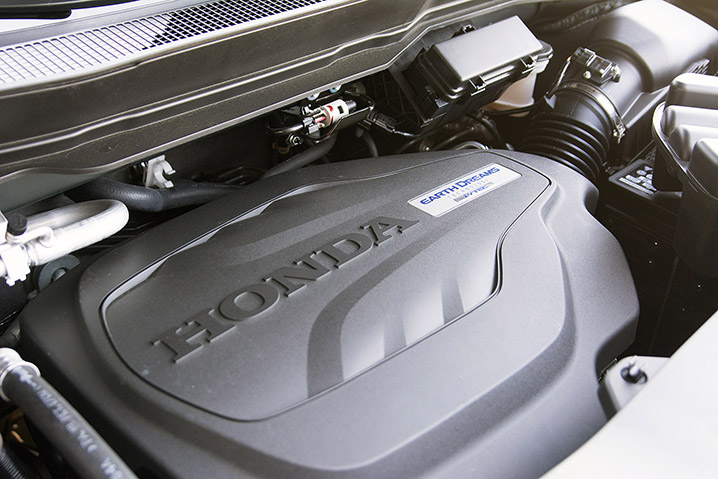
The 9-speed auto feeds power to an all-new, torque-vectoring all-wheel-drive system with an electronically controlled rear differential. According to Honda, the new Intelligent Variable Torque Management system can not only shift up to 70 percent of the engine's oomph to the rear axle, but it is also able to move torque laterally. It seems fine on flat, dry pavement, but we'll have to get the Pilot off the beaten path to see how this system fares in rugged conditions.
Honda is claiming best-in-class fuel economy in the 2-wheel drive model, with a predicted 20 miles per gallon in the city and 27 mpg on the highway in 2-wheel drive. All-wheel drive drops both figures by a single unit.
The comprehensive Pilot overhaul extends well past the powertrain. Front struts with amplitude-reactive dampers and an all-new multi-link rear suspension with coilover dampers underpin the Honda. The handling is exactly as you'd expect of a family oriented 3-row CUV Ė soft and portly. However, our curvy, dynamic drive route through Kentucky didn't do the Pilot Elite any favors. These twisty roads better accentuated the 4,300-pound curb weight rather than the nearly 300-pound weight loss.
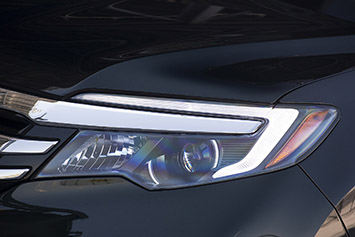
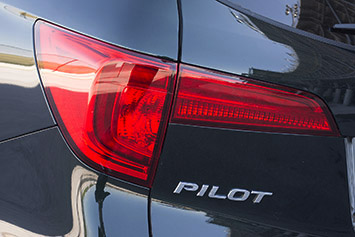
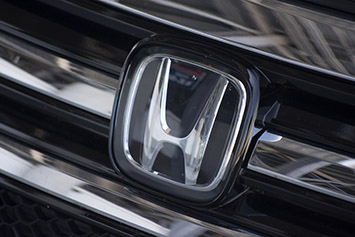
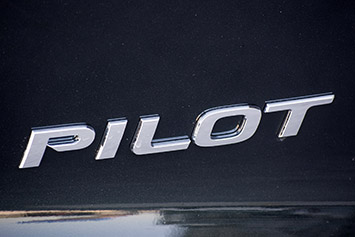
Honda's electric power steering is more or less par for the course. It's tight for a large crossover, with a 16:1 ratio and just over 3 turns from lock to lock, but we found ourselves working the tiller a bit more than we'd like. Tiny corrections are necessary, due to the lack of feedback through the wheel.
The Pilot rolls through the bends and dives under hard braking, neither of which come on progressively. But the Pilot hardly felt sloppy. Besides, the vast majority of consumers will never come close to pushing the big Honda as hard as we did during our drive route. For the families buying a Pilot, it's as agile as it needs to be.
Far more important to consumers is the way the Pilot rides. It's comfortable in the city and on the highway, even with our Elite model's 20-inch wheels. Small pavement imperfections are soaked up easily. Kentucky's smooth roads are a blessing, but we wonder if the Pilot won't feel a bit rougher once we get it out on the choppy roads of Detroit.
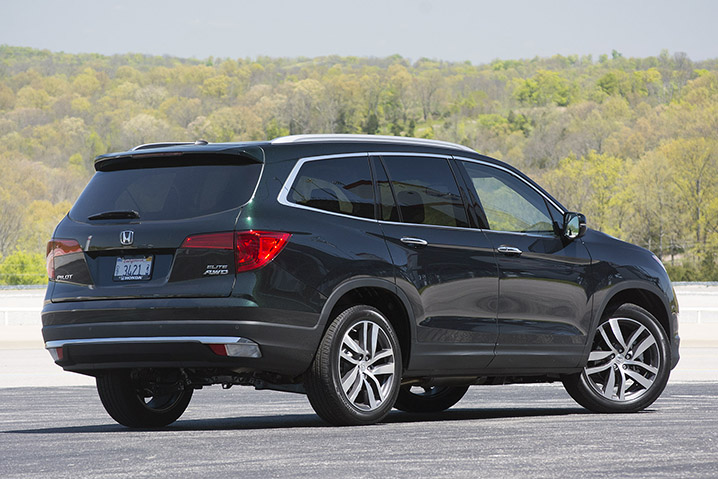
Prices for the 2016 Pilot start reasonably enough, at $29,995, plus $880 for destination. That's within $1,000 of both the pricier Explorer and the more affordable Pathfinder. Adding all-wheel-drive increases the price by $1,800, regardless of trim. There are a spate of trims to choose from, starting at the base LX, then building through the EX and EX-L Ė both of which feature sub trims that add additional equipment Ė and into Touring and the top-of-the-line Elite. We drove the most expensive model, the $46,420 Elite. That's slightly more dear than a loaded Pathfinder ($45,685), but significantly less than a fully optioned Ford Explorer Limited with the 2.3-liter EcoBoost. The Pilot Elite is pricey, but not extravagantly so.
Honda has built a thoroughly modern 3-row crossover that won't only perform well in its class, but will probably steal at least a few sales from more premium vehicles Ė think Acura MDX and Infiniti QX60. The Pilot's smooth ride, handsomely appointed interior, high-tech safety systems, and efficient powertrain will play well with a range of customers. Most importantly, though, the Pilot will be highly appealing to value-minded families, perhaps more than ever before.
The following users liked this post:
Legend2TL (05-20-2015)
#428
Safety Car
The 2nd-generation Pilot was a sales success for Honda, but it wasn't exactly the company's greatest achievement.
At a time when most crossovers were embracing their car-based roots with sleeker styling, the 2nd-gen Pilot arrived for 2009 with boxy proportions reminiscent of SUVs from yesteryear. Things weren't much better on the inside where cheap materials and a mishmash of SUV and minivan design elements created a less-than-inviting space.
Honda is now wiping the slate clean with an all-new Pilot for 2016. Things can only get better from here.

CR-V Plus
The 2016 Pilot ditches the squared off proportions of last year's model in favor of a more angular look inspired by the current CR-V. Considering how popular the CR-V is, that's probably a wise move on Honda's part.
The Pilot's front end is highlighted by a 3-bar chrome grille that flows into the SUV's new-look headlights. Like the smaller CR-V, the Pilot features LED accent lighting the boomerangs around the top and sides of the headlamps. Upper-end models like our Elite tester also receive fog lights in the lower portion of the bumper.
In profile the Pilot reveals more of its CR-V DNA. Like the CR-V, a main character line runs through the Pilot's door handles while a secondary crease graces the sill line. A rising belt line at the rear mimics the CR-V's design, but the Pilot lacks the sharply-raked D-pillar of its little brother. Black cladding protects the Pilot's lower paint on all sides.
The rear of the Pilot is uniquely its own, with large taillamps transitioning to thin strips when they cross over to the tailgate. Just above the rear window curves upward at the corners in an effort to make the big SUV seem a bit more shapely. A chrome accent on the lower bumper adds to the Pilot's new premium positioning.
Overall, the 2016 Pilot is a far more contemporary vehicle than the old model ever was.

Acura Minus
While the exterior of the Pilot is similar to that of the lesser CR-V, the interior of the SUV is closer to what you'd find in Honda's line of Acura luxury vehicles. The overall design is clean and simple with a clear focus on reducing the number of buttons and shift levers cluttering the dashboard.
Where there was once thousands of switches and knobs to control stereo and infotainment functions there are none; a single, 8-inch touchscreen now handles everything. Controls for the Pilot's HVAC system sit just below and are easy to use. We particularly like the toggle switches used for temperature control.
1 of the most notable changes from last year's Pilot is the adoption of a push-button shift arrangement on models equipped with Honda's 9-speed automatic transmission (6-speed models get a traditional lever). The switch eliminates the need to have a gear lever poking out from somewhere, but it doesn't free up a whole lot of extra room. Unlike the Chrysler 200, which also uses a shift-by-wire system, there is no storage area directly below the shifter. To us it seems like a case of reinventing the wheel just for the sake of it.
A large storage area resides just behind the shift lever. In addition to being large enough to hold a moderately sized purse, the cover is also rigid enough to support additional items. Smaller items can be stashed in a small cubby-hole that includes power outlets just under the center stack.

The Pilot uses Honda's familiar multi-fiction steering wheel. In addition to housing controls for the radio and and cruise control, the leather wrapped unit also includes paddle shifters on models equipped with the 9-speed auto.
The Pilot's gauge cluster is straightforward with a traditional dial on the left to keep track of revs and 2 more on the right to monitor temperature and fuel. Speed is displayed on a digital readout just above a center-mounted color TFT screen. It doesn't come across very well in photos, but the dials and needles on the physical gauges have a 3-dimensional design that gives a more up-scale feel than you'd typically associate with a Honda.
Cheap plastics were a major criticism of the last Pilot but Honda has mostly rectified that issue in the new model. The dash and the top sections of the front doors are now covered in soft materials and feature faux stitching. Rear seat passengers aren't as lucky - even in our top-of-the-line $46,000 Elite test car the rear doors are shod in hard plastic, which seems like an oversight.
A few missteps not withstanding, the interior of the new Pilot is a supremely pleasant place to spend any length of time. Front seats are pillowy soft and easily among the most comfortable in the segment. 2nd row passengers might not be treated to the best materials, but they do get plenty of storage, including 2 cupholders and a lower cubby molded into each of the rear doors. 3ird row seats typically offer the space and comfort of a shoebox, but not so in the 2016 Pilot. A human being with average proportions can actually sit in the way-back without needing to 1st cut off their head and legs. As long as they're not claustrophobic, 2 6-footers could ride around in the back of the Pilot without issue. And if you do start to feel closed in, you can always open the Pilot's optional panoramic sunroof, which is a 1st for the Honda brand.
Getting into and out of the 3rd row is also a lot easier thanks to Honda's latest 2nd row mechanism. Buttons located on the side and the back of the 2nd row activate a spring mechanism that propels the 2nd row forward with ease. You still have to be somewhat of an athlete to access the 3rd row, but it's certainly a lot easier than it was during the early days of 3 row utility vehicles. In models equipped with 2nd row bucket seats, the center console has been designed to be sturdy enough to support people climbing over to the 3rd row.

Infotainment and all things electronic
Of course all of the Pilot's newfound style and comfort wouldn't mean much if it just had a tape deck stuffed in the dash. Luckily, it doesn't - it comes with Honda's latest Android-based Display Audio System.
1st off, Apple users fear not; the Android system plays nice with Apple's iOS. Although we weren't able to test that claim for ourselves, Honda promises the system will "support seamless iPhone integration."
We did get to spend a couple of hours playing with the system's other features and came away impressed. The 8-inch screen offers excellent resolution and was quick to respond to our touches. Any modern infotainment system inherently comes with some kind of a learning curve, but we were able to plod through Honda's latest head unit without much fuss.
Navigation is provided by Garmin and includes live traffic updates, 3D mapping and speed limit information. Navigation hasn't historically been a strong suit of recent Honda vehicles, but the unit in the Pilot is just as good as anything else you'll find on the market.

A good chunk of drivers will probably rely on their personal libraries or apps like Pandora for music, but the Pilot has a pretty trick SiriusXM system built-in. A new Tune Start function acts like a DVR for your radio, recording the portions of a song you might have missed. If you switch to another station only to hear the tail end of your favorite song, you can have the system rewind to the beginning.
Sports fans will be interested in the Sports Flash function. You can store up to 5 of your favorite sports teams in the system and then have the head unit automatically update you with 30-second clips. No need to switch back and forth between music and sports, the system will automatically cut in with a highlight clip whenever anything notable happens.
Our favorite function is Tune Mix. Like a personal DJ, Tune Mix pulls songs from all of you favorite SiriusXM radio stations and combines them into 1 station. Tune Mix borrows the DVR function from Tune Start to cache songs from other stations so you never miss a beat.
But all is not well with Honda's new head unit. As with other Honda touchscreens, the traditional volume knob has been replaced with a slider. We found the slider to be disobedient and not easy to locate while concentrating on the road ahead.
2nd- and 3rd-row passengers can stay entertained with an optional Bluray DVD player. Despite the addition of a panoramic sunroof, Honda kept the screen on the roof to help reduce the chance of experiencing motion sickness. Every passenger can keep charged up thanks to 5 USB ports spread throughout the Pilot's interior.

Driving experience
The Pilot offers a nice blend of performance and economy, but our biggest takeaway was the SUV's outstanding comfort and noise isolation.
Honda stripped more than 280 pounds from the Pilot's waistline, but you'd never guess that from the driver's seat. That not because the Pilot is heavy or ponderous to drive, it's not, but because it just feels so damn solid.
Torsional rigidity is up 25% in the new model and that's clearly evident from the second you slide behind the wheel. The Pilot gives you that same kind of tank-like feeling that you get from an old Volvo.
A new suspension system makes use of that stiffer base, returning a ride that is soft and comfortable yet composed when the road turns twisty. The Dodge Durango is still a better drive, but we doubt the average Pilot buyer will find anything to complain about.
The interior of the Pilot is quiet enough to put some luxury models to shame. Road and wind noise are virtually nonexistent, even at highway speed. Even the electric windows in the Pilot go up and down with little more than a faint whisper.

Honda's 3.5L direct-injection V6, which is rated at 280 horsepower and 262 lb-ft of torque, provides the Pilot with plenty of scoot. Most of our time was spent with the 9-speed auto, but we did get a chance to sample the 6-speed, which Honda says will be the volume gearbox. The 9-speed provided slightly faster gear changes, but that's about the only difference we could discern during or short stint behind the wheel.
Front-wheel drive comes standard but buyers can opt for all-wheel drive. A Honda 1st, the Pilot's AWD system now comes with a torque vectoring system. Whereas other torque vectoring systems use brake drag to help with cornering, Honda's system sends more power to the outside wheels, which Honda says is a more effective solution. In order to keep up with the Joneses, the Pilot's AWD system also features settings for Snow, Mud and Sand. A Sport mode is available on 9-speed models.
Honda's available Honda Sensing safety suite includes the latest assistance tech, including adaptive cruise control, lane keeping assist, forward collision warning and road departure mitigation. Top-spec Elite models can be further outfitted with a blind spot information system and rear cross traffic monitor.
All of those systems generally work as advertised, but we did come across an issue with the Pilot's adaptive cruise control. We found that the system was sometimes slow to detect a vehicle ahead, which resulted in a few instances of abrupt braking. In fact, more than once the system brought us so close to the bumper of the car ahead that it flashed a brake warning message.
Fuel economy is quite good with front-wheel drive models returning 27mpg on the highway. The 9-speed has a 1mpg advantage in city driving over the 6 -- 20mpg versus 19mpg. Stepping up to AWD nets a 1mpg ding across the board for both transmissions.

Leftlane's bottom line
From so-so to standout, the 2016 Honda Pilot is suddenly 1 of the best 3-row crossovers you can buy. Combining the rarity of a usable 3rd row with luxury-levels of quiet and comfort, the Pilot is a win-win for the entire family.
2016 Honda Pilot 2WD LX base price, $29,995. As tested (4WD Elite w/RES and Navi), $46,420. Destination, $880.
#429
Wow, I am pretty surprised they went with (skinned) Android for the touchscreen. This is the first OEM system based on a full mobile OS if I'm not mistaken. (I don't count CarPlay/Android Auto which only run off your phone)
Hope other companies follow their lead.

Hope other companies follow their lead.

#430
Safety Car
The advent of a 2nd child in a coupleís life can mean many things: the demise of romance, the start of sibling rivalry, and the purchase of a 3-row SUV. As the latter has all but usurped the minivan as the most popular kid-schlepper, the Honda Pilot has risen to become a go-to choice for frazzled parents. The Pilot is rarely seen without at least 1 magnet displaying allegiance to a school or sportóas well as those annoying stick-family decalsóand its ubiquity is a testament to its competence, not its pleasantness.
Honda reliability, a roomy interior, and a practical shape are what sell the Pilot. Absent is any sense of style or indulgent luxury. The new 2016 Pilot seeks to amend that and, in so doing, take some of the drudgery out of parenthoodóeven as it delves further into its role as a minivan proxy.

Getting Off the Block
Always competent, the Pilot didnít need a rethink, just refinement. For the 3rd-generation model, that refinement starts with the styling. Honda tells us that the #1 reason SUV shoppers bypassed the old Pilot was its styling, and indeed, the previous model looks like it might have been designed using Duplo blocks. Whereas the old version tried to look tough, the new model prefers to be sleek, employing a unified side-glass area, swept-back corners on the familial Honda front end, and a friendly upkick at the tail end of the beltline. The front and rear are brightened with LED lighting, and 20-inch wheels are now available.
The new Pilot is slightly largeróby 1.8 inches in wheelbase, 3.5 inches in lengthóand yet its additional inches did not bring with them additional pounds. In fact, Honda claims the Pilot has slimmed down by as much as 286 pounds. Its weight of roughly 4100 to 4400 pounds (depending on equipment) are commendably svelte for this portly class. As busy parents know, family duty often is a recipe for packing on extra flab, so give the new Pilot a supportive round of applause for its weight-loss success. (As on The Biggest Loser, however, weíll need to verify the lightening on a set of scales.)

A 3.5-liter V-6 again powers the Pilot, but this is a new, direct-injected engine. A variant of the unit in the Acura MDX, it makes 10 fewer horsepower here but runs on regular fuel. Its output figures of 280 horsepower and 262 lb-ft of torque handily beat the old engineís 250 and 253. The previous 5-speed automatic has been scrapped in favor of a 6-speed in LX, EX, and EX-L models, while the fancier Touring and new Elite trim levels are fitted with the ZF 9-speed also borrowed from Acura. The 9-speed gets shift paddles along with the same, rather gimmicky, push-button gear selector Acura uses; the 6-speed gearbox is actuated via a conventional shift lever.
With more power, additional gears, and less weight, the Pilot is said to hustle to 60 mph some 2 seconds faster than before. More important, it slurps less fuel. EPA figures increase from 17/24 mpg (AWD) to 18/26 mpg, as well as to 19/26 for Touring and Elite models, which in addition to the 9-speed automatic also come with auto stop-start (the latter deserving the lionís share of the credit for the slightly better city-mpg rating). Front-wheel drive adds 1 mpg to the above figures. All-wheel-drive models get a choice of 4 powertrain modes: Normal, Snow, Sand, and Mud, which replace the previous VTM-4 Lock button. The AWD system also has a torque-vectoring function, which can apportion torque across the rear axle to aid cornering. AWD versions are rated to tow 5000 pounds, up from 4500, while FWD models can tug only 3500 pounds.

Nearly an Odyssey
1 might expect a livelier powertrain and relatively light weight to make for a more engaging driving experience, but thatís not really what the Pilot is all about. On the narrow, winding byways of northern Kentucky where we previewed the crossover, the Pilot just felt large. The steering, now electrically assisted, is overly light at low speeds and doesnít load up appreciably as you wind on more lock, making it less confidence-inspiring than it might be; the old modelís hydraulically assisted steering felt meaty and substantial by comparison. Nor were we enamored of the brake-pedal feel, as the 1st 3rd of the pedal travel produces little braking action. Ride quality, though, is quite good, as the Pilot gets a redesigned multilink rear suspension and also gains amplitude-reactive dampers. EX-L and higher trim levels add acoustic glass to make for quieter cruising. Much more so than its predecessor, the overwhelming feeling from behind the wheel is that youíre driving a minivanóa plush, comfortable minivan, but a minivan all the same.
That impression comes not just from the dynamics but also from the packaging. The cabin feels much wider than before; the larger, more steeply raked windshield is farther away; and the hood is short. Thereís even 1 of those convex, school-bus-driver mirrors in the overhead console. The towering center armrest has been ditched in favor of minivan-style flip-down armrests attached to each seat, which opens up elbow room. In the resultant space sits a low console with a tambour lid, which Honda points out makes a great perch for a purse or a fast-food bag (they know their market so well).

Whereas the old Pilotís dashboard was a cliff-like hunk of industrial-grade plastic, the new 1 has been completely redesigned into a slimmer, more attractive interface, accented with either matte-gray or gloss-black trim, and padded surfaces abound on the dash and door panels. Unfortunately, the new Pilot also sees the installation of Hondaís ergonomically awful, touch-screen infotainment interface, which banishes all physical buttons and knobs. Itís standard on all models save the base LX whether or not you get the Garmin-based navigation system.
Safety is always a parental obsession, and the new Pilot is now onboard with the latest collision-avoidance technology, although some of it is reserved for the upper trim levels. Forward-collision warning with automatic braking, adaptive cruise control, lane-departure warning, and lane-keep assist (which allows a measure of hands-free driving) are all new additions; theyíre standard on the Touring and Elite, optional on the EX and EX-L, and not available on the LX. A blind-spot warning system is combined with rear cross-traffic alert, but theyíre only on the Elite. Other Elite exclusives include a new panoramic sunroof, ventilated front seats, heated rear seats, a heated steering wheel, LED headlights, and automatic high beams. All thatís missing is the built-in cargo-area vacuum that Honda introduced on the Odyssey.

The Elite comes with individual 2nd-row seats, which, surprisingly, were unavailable before. Some parents consider them essential to avoiding back-seat warfare, although they drop the official seating capacity to 7óor 6 in the real world, given that 3 across in the 2rd row is pretty optimistic. To get at the standard 3rd row, EX-L and higher trims have an easy-to-use 1-touch button that scoots the 2nd-row seats forward. Honda claims to have carved out greater access to the 3rd row, but itís still not an easy climb for grown-ups. Space back there is not bad, but the cushion is very low to the floor and flat. With all seats in place, luggage capacity is better than most, with room for a quartet of standard-size roller bags to stand up behind the rearmost seatback.
In all, the Pilot makes a fine minivan substitute for when that 2nd kid comes along. And it looks better doing itóat least until you put those magnets and stickers on the back.

The following users liked this post:
Legend2TL (05-26-2015)
#432
Senior Moderator
Im really liking this new pilot.
#433
Safety Car
The Honda Pilot has been transformed.
FAST FACTS
Engine: 3.5L V6 with 280 hp and 262 lb-ft or torque.
Transmission: 6-speed automatic or 9-speed DCT automatic
Fuel economy: Varies from 20/27/23 city/highway/combined (9AT FWD) to 18/26/21 (6AT AWD)
Price: From $30,875 to $47,300
From a utilitarian box on wheels to a sleek near-luxury SUV the style shift is almost shocking in its departure from the past.Engine: 3.5L V6 with 280 hp and 262 lb-ft or torque.
Transmission: 6-speed automatic or 9-speed DCT automatic
Fuel economy: Varies from 20/27/23 city/highway/combined (9AT FWD) to 18/26/21 (6AT AWD)
Price: From $30,875 to $47,300
Pairing that dramatic redesign with a long list of upgrades, does this latest model have what it takes to put the Pilot at the helm of the 3-row crossover segment?
Bu-Bye Box
While we should keep you waiting with a line like ďyouíll never guess what happens next,Ē the short answer is: yes.
Over the past few years utility vehicles like the boxy Ford Escape and the square Nissan Pathfinder have traded in their chiseled looks for a more curvy appearance. Now the Pilot is following that trend, and for good reason. Or should we say reasons.
1st and foremost is the truckís perception.
Hondaís market research surrounding the previous generation Pilot indicates that the 2 main rejection reasons for that model were styling and fuel economy. According to their research, people saw the boxy shape and assumed that it was bad on gas. This was true even when the Pilot had best-in-class fuel economy and continued to haunt it as the truck grew older and gave up that title to more modern rivals.
Of course, if youíre in the opposing camp and you did like the look of the old Pilot you can always blame Obama.
How is this Obamaís fault? Well, itís called government mandated corporate average fuel economy standards and for Honda to hit its targets, it needs sleek aerodynamic shapes in order to eek our every last mile per gallon. Thankfully, you, the consumer, get to reap the reward.
Gone is the big boxy grille. It also looks longer and lower, because it actually is. The Pilot shaves an inch off the top and adds 3 inches in length overall, with roughly 2 inches between the wheels and an inch of extra rear overhang.
But Honda has done so much more to make the new Pilot a fuel economy leader.
Lighter, Faster, More Efficient

For starters they shaved almost 300 lbs from the curb weight. Theyíve also added a new V6 that makes 30 HP more than the previous 1 but gets better fuel economy thanks to direct injection, cylinder deactivation and a start-stop system on higher grades.
Thereís a new 6-speed transmission replacing the old 5-speed unit because, well . . . itís not 2001. Plus, high-spec models (Touring and Elite) get a new 9-speed unit thatís actually 66 lbs lighter than the 6 and offers shift times that are 25 percent faster.
Regardless of which trim, the Pilot is right at the front of the pack for fuel economy and will average from 21 to 23 mpg. On the meandering country roads of Kentucky we managed as high as 26 MPG.
On The Road and Off It

Driving the Pilot, you now sit an inch lower while ground clearance is 7.3 inches, which is lower than the Toyota Highlander, but taller than the Pathfinder.
The old Pilot scored poorly when it came to noise, vibration and harshness (NVH) so with the new model significant efforts, including added insulation and thicker glass, have been made to improve sound deadening. And it shows.
It also feels noticeably quicker and Honda claims a 0-60 time of around 7 seconds. Faster, itís more nimble too, due partly to the weight reduction, but thereís also a lot going on underneath you.
Most importantly, there is an all-new all-wheel drive system that is essentially a hand-me-down version of Acuraís Super Handling AWD setup. Called i-VTM4 it, sends 100 percent of the power to the front wheels but can send up to 70 percent to the rear when needed and all of that can be delivered to just 1 rear tire to push you through a corner.
To help make the most of i-VTM4, Honda borrowed a page from the leaders in the off-road segment and added what it calls an Intelligent Traction Management button on the center console. This lets the driver chose different pre-set models for the terrain. Front-wheel drive models get a choice of Normal or Snow, while all-wheel drive versions let you select from Normal, Mud, Sand and Snow modes.

Unfortunately the smooth, swerving roads of our test drive route are no place to experience the benefits of any of these settings. They are, however, ideal for feeling-out the 9-speed auto and start-stop system.
The latter does mean the Pilot takes about a half-second longer to leave the line, which is a small annoyance.
It may also be to blame for a sudden hiccup in the Pilotís otherwise smooth demeanor, with the truck lurching away from a stop. Perhaps an exceptionally speedy pause at a stop sign is to blame, with the stop-start system killing the engine just as we reapplied the throttle.
Room for the Family, and Then Some

Getting back to the truckís size, the increases put it near the front of the pack when it comes to cargo room Ė a category Honda almost always dominates in. Try as it might, thereís just no competing with the acres of real-estate inside the GM trio (Chevy Traverse, GMC Acadia and Buick Enclave).
As for passenger space, 2nd row legroom is ideal though 3rd row space is the most impressive, with actual legroom for 6-foot tall adults. Thatís something almost none of this truckís rivals can claim, again, the exception being the GM 3.
For the 1st time the Pilot comes with available captainís chairs for the 2nd row and to improve access to the 3rd row thereís a new 1-touch fold mechanism for the outboard 2nd-row seats. Press the electronically operated button on the side of the seat (or the top of the seatback if youíre in the 3rd row) and it mechanically tilts and slides forward, leaving a space thatís 2.5 inches wider and 1.2 inches lower than the opening on the old Pilot. Ingress is now far easier, though exiting the Pilot gracefully isnít something anyone under the age of 14 will ever master.

From behind the wheel, the interior updates are as dramatic as the exterior ones. Gone is the overtly utilitarian cabin of the old model that was styled more like something out of a pickup. Itís been replaced by a modern design and high quality materials.
1 of the most noticeable updates are the new buttons on the center console for operating the transmission Ė a piece lifted almost directly from Acura.
The dash itself is much cleaner, thought it does seem like a lot of the buttons have just been moved onto the steering wheel.
Thereís a big 8-inch touchscreen on all but the base model thatís simple and intuitive to use. The only issues arise when performing more meticulous operations. Scrolling through lists of songs, the screen sometimes reacts slower than youíd like. That, and Hondaís volume control slider is just annoying to use. Thankfully there are redundant controls on the wheel.
So many important additions have been made to the Pilot that the official product document Honda provided stretched for 120 electronic pages. In the interest of brevity (and sanity) weíll point out just a few of the most notable new features.
A push button ignition is now standard, while keyless access and remote start come on all but the base model. Honda kept the massive center console area that can hold a whole purse and added USB plugs. Lots of them. There are now 5 places to plug in.
A heated steering wheel is also now available, though, unfortunately, like with the Odyssey, you can only get it on the top Elite level model.
That Elite trim level is impressive and includes a panoramic glass roof, heated and ventilated front seats and heated 2nd-row captainís chairs as well as LED headlights and the 1st use of 20-inch wheels on a Honda.
Safety 1st
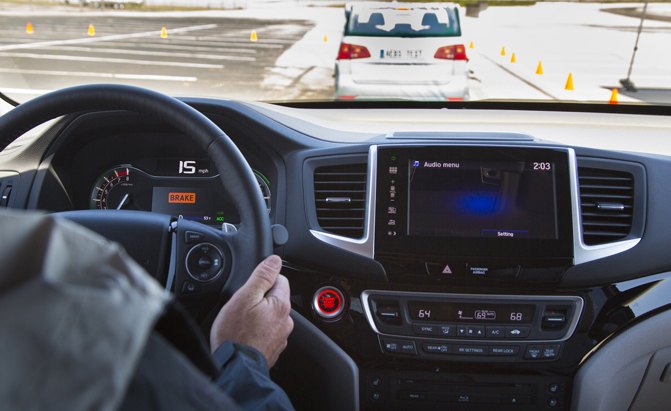
Safety is always a priority with a family-focused machine and so the Pilot comes equipped with the brandís new Honda Sensing package. 1st introduced on the updated 2015 CR-V, it now includes more features and is available on a wider array of trim levels.
Standard on the Touring and Elite models, its available as an option on the EX and EXL and includes adaptive cruise control, forward collision warning, lane departure warning as well as lane keeping assist and road departure warning, both of which work to keep you in your lane using 1st steering and, if necessary, braking.
Also a part of the package is an auto brake feature that can slow or even stop the car on its own to prevent or reduce the severity of an impact.
Oddly, blind spot monitoring is only available on the top trim, though you might not miss it as all models come standard with Hondaís Lane Watch system that projects whatís in your right-hand blind spot right onto the display screen.
The Verdict: 2016 Honda Pilot Review

In our recent 3-row crossover shootout, the old Pilot finished in a dismal 6th place.
It did the basics right but in other areas it was simply outclassed. The 2016 model makes huge strides in the driving experience, interior, safety and technology while still managing to improve on already strong fundamentals like passenger and cargo room as well as fuel economy.
So should you buy 1? For so many cars the answer to that question is ďit depends.Ē
But for all the reasons just mentioned, this time itís a resounding yes.
LOVE IT
Much quieter cabin
Most fuel efficient (non-hybrid) in its class
New safety features
Cabin and cargo room
LEAVE IT
Heated wheel only on top trim
Slight delay with start-stop
Touch screen can be laggy
#434
Senior Moderator
Looks like a very nice improvement. However, ostensibly doesn't make me regret getting my 15 MDX Tech.
I look forward to seeing it tested in mags.
I look forward to seeing it tested in mags.
#439
AZ Community Team
Didn't drive it but I've looked at the 2016 Pilot while picking up some parts from local dealer. Really impressed with the looks, features,/functions, and quality of materials. All that was wrong with the 2G Honda fixed on the 3G. My only problem is keeping my wife from etting one, while convincing her to keep her 2003 with 258K miles still going strong.
#440
RECALL Subject : Rear Seatbelt May Be Trapped
Report Receipt Date: JUL 06, 2015
NHTSA Campaign Number: 15V424000
Component(s): SEAT BELTS
Potential Number of Units Affected: 1,358
All Products Associated with this Recall
Vehicle Make Model Model Year(s)
HONDA PILOT 2016
Details
Manufacturer: Honda (American Honda Motor Co.)
SUMMARY:
Honda (American Honda Motor Co.) is recalling certain model year 2016 Honda Pilot vehicles manufactured May 4, 2015, to June 5, 2015. Due to an assembly issue, the third row seatbelt may be trapped between the rear seat and the rear sideliner.
CONSEQUENCE:
If the third row seatbelt is trapped, the occupants may not be restrained properly, increasing the risk of injury.
REMEDY:
Honda will notify owners, and dealers will inspect and repair the rear third row seat belt, free of charge. The recall is expected to begin on August 6, 2015. Owners may contact Honda customer service at 1-310-783-2000. Honda's number for this recall is JS7.
NOTES:
Owners may also contact the National Highway Traffic Safety Administration Vehicle Safety Hotline at 1-888-327-4236 (TTY 1-800-424-9153), or go to Home | Safercar -- National Highway Traffic Safety Administration (NHTSA).
Statement by American Honda Regarding Third Row Seatbelt Inspection Recall: 2016 Honda Pilot
Only twenty 2016 Pilot vehicles in customer hands require inspection at the time of this announcement
Third row seatbelts will be inspected and, if needed, repositioned
No related crashes or injuries have been reported
TORRANCE, Calif. Ė July 16, 2015 Ė Honda will voluntarily recall fewer than 1,700 model-year 2016 Pilot vehicles in the United States to inspect, and, if needed, reposition the third row seatbelts, free of charge. However, because only 269 of these new vehicles actually had been delivered to owners before Honda notified NHTSA and an inspection and repair process was available to dealers, Honda was able to quickly contact affected owners to schedule an inspection, and only 20 customer vehicles still require an inspection as of the date of this statement. Any vehicles in transit from the factory or in inventory at a Honda dealer have been or will be inspected and, if needed, repaired prior to sale.
During assembly of the third row seat and seatbelt, it is possible that the rear (third row) seatbelts could be trapped between the rear seat and the interior side panel. If a rear seatbelt is trapped, any occupant using the seatbelt may not be properly restrained in the event of a crash, increasing the risk of injury. No crashes or injuries have been reported related to this issue, which was discovered during factory quality inspections.
Honda is announcing this recall to encourage the owners of the 20 remaining affected vehicles to take them to an authorized dealer as soon as possible for inspection and, if needed, repair. All affected vehicles are eligible for inspection now, and owners of a 2016 Pilot can determine if their vehicles require inspection by going to Recall Information for Safety & Defects | Honda Owners Site or by calling (800) 999-1009, and selecting option 4. Mailed notification to owners of any remaining uninspected vehicles will occur within 60 days.
Report Receipt Date: JUL 06, 2015
NHTSA Campaign Number: 15V424000
Component(s): SEAT BELTS
Potential Number of Units Affected: 1,358
All Products Associated with this Recall
Vehicle Make Model Model Year(s)
HONDA PILOT 2016
Details
Manufacturer: Honda (American Honda Motor Co.)
SUMMARY:
Honda (American Honda Motor Co.) is recalling certain model year 2016 Honda Pilot vehicles manufactured May 4, 2015, to June 5, 2015. Due to an assembly issue, the third row seatbelt may be trapped between the rear seat and the rear sideliner.
CONSEQUENCE:
If the third row seatbelt is trapped, the occupants may not be restrained properly, increasing the risk of injury.
REMEDY:
Honda will notify owners, and dealers will inspect and repair the rear third row seat belt, free of charge. The recall is expected to begin on August 6, 2015. Owners may contact Honda customer service at 1-310-783-2000. Honda's number for this recall is JS7.
NOTES:
Owners may also contact the National Highway Traffic Safety Administration Vehicle Safety Hotline at 1-888-327-4236 (TTY 1-800-424-9153), or go to Home | Safercar -- National Highway Traffic Safety Administration (NHTSA).
Statement by American Honda Regarding Third Row Seatbelt Inspection Recall: 2016 Honda Pilot
Only twenty 2016 Pilot vehicles in customer hands require inspection at the time of this announcement
Third row seatbelts will be inspected and, if needed, repositioned
No related crashes or injuries have been reported
TORRANCE, Calif. Ė July 16, 2015 Ė Honda will voluntarily recall fewer than 1,700 model-year 2016 Pilot vehicles in the United States to inspect, and, if needed, reposition the third row seatbelts, free of charge. However, because only 269 of these new vehicles actually had been delivered to owners before Honda notified NHTSA and an inspection and repair process was available to dealers, Honda was able to quickly contact affected owners to schedule an inspection, and only 20 customer vehicles still require an inspection as of the date of this statement. Any vehicles in transit from the factory or in inventory at a Honda dealer have been or will be inspected and, if needed, repaired prior to sale.
During assembly of the third row seat and seatbelt, it is possible that the rear (third row) seatbelts could be trapped between the rear seat and the interior side panel. If a rear seatbelt is trapped, any occupant using the seatbelt may not be properly restrained in the event of a crash, increasing the risk of injury. No crashes or injuries have been reported related to this issue, which was discovered during factory quality inspections.
Honda is announcing this recall to encourage the owners of the 20 remaining affected vehicles to take them to an authorized dealer as soon as possible for inspection and, if needed, repair. All affected vehicles are eligible for inspection now, and owners of a 2016 Pilot can determine if their vehicles require inspection by going to Recall Information for Safety & Defects | Honda Owners Site or by calling (800) 999-1009, and selecting option 4. Mailed notification to owners of any remaining uninspected vehicles will occur within 60 days.







